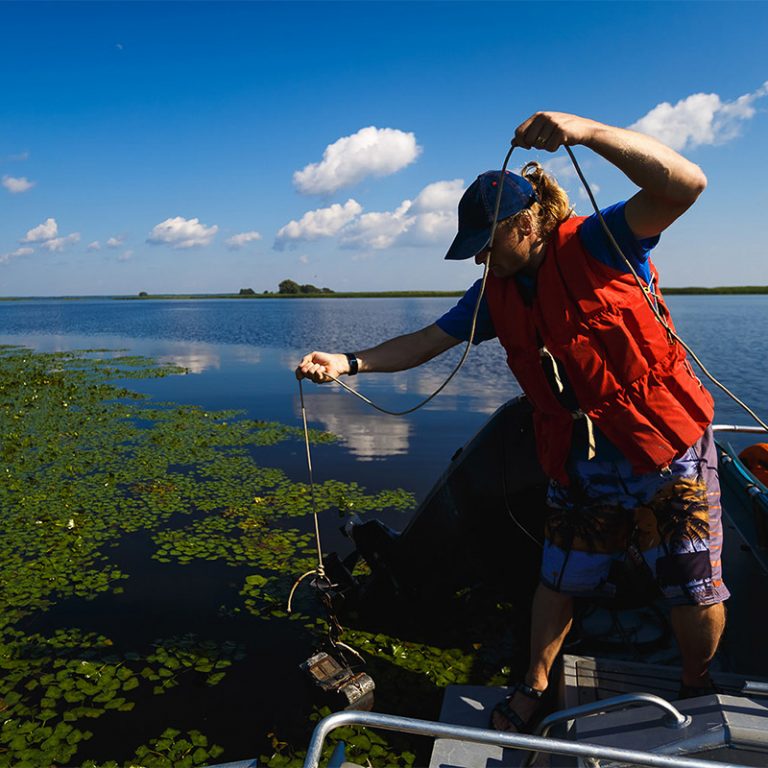The construction of the Dnipro Hydroelectric Power Plant (HPP — tr.) resulted in 90% of the river being regulated by dams and reservoirs. Since then, the Dnipro has been blooming periodically with algae. A group of scientists from the Institute of Hydrobiology of the National Academy of Sciences of Ukraine, led by Olena Bilous, has a hypothesis that certain plants can restore the chemical balance in the Dnipro river, and thus solve the problem of blooming. To test their theory, the team is organizing an expedition through the Dnipro reservoirs and exploring the relationships in this artificially altered ecosystem.
Algal blooms occur where rivers and lakes are irresponsibly exploited. Human activities upset the balance of the ecosystem, resulting in the uncontrolled reproduction of algae, which emit toxins and take oxygen from other living organisms. This problem caught the attention of the government and researchers in Ukraine when the Dnipro started blooming, since the river is an important source of drinking water and electricity.

The Blooming Dnipro
The Dnipro is the largest and longest river in Ukraine. The Dnipro’s importance is difficult to overestimate: flowing through several regions from north to south, it provides drinking water to more than half of the country’s population.
The Dnipro is also a unique ecosystem that supports great biodiversity. Dozens of fish species live here, as well as the river beaver, mink and otter, which are listed in the Red Data Book of Ukraine (the national list of endangered species — tr.). Not surprisingly, many national reserves (such as Kaniv Nature Reserve) and landscape parks lie along the river.
Moreover the Dnipro is an irreplaceable source of electricity. The groundbreaking DniproHPP-1 project was built between 1927 and 1939, at which point it became the largest hydroelectric power plant in Europe. The 1960s saw the start of the construction of Dnipro HPP-2. This resulted in the lion’s share of the river being regulated by dams and turned into a cascade of six reservoirs. Since then, vessels have been able to navigate the entire length of the Dnipro — previously rapids got in the way. Today all the hydropower plants on the Dnipro produce over 9.4 billion kW of energy annually — about 4.5% of the country’s total energy production.
At the same time, the artificial alteration of the ecosystem had negative consequences, such as changes in the hydrological and hydrochemical makeups of the river. Ecologist Olena Bilous is studying the excessive spread of algae in the Dnipro, in particular in the Kyiv and Kaniv reservoirs. In her view, this process has become a problem that goes beyond just scientific interest:
“This concerns anyone who observes this pretty heavy blooming in our reservoirs.”

Bilous has been studying algae for many years. She says it was not hard to choose her profession: Olena was born into a family of biologists, who encouraged her interest in science from a young age. In 2009, she started her PhD studies and work at the Institute of Hydrobiology of the National Academy of Sciences of Ukraine, an institution that takes care of the country’s water resources. They study the biodiversity of freshwater systems, the species composition and behaviour of aquatic organisms, and conduct molecular and cellular research.
Olena Bilous is now a senior researcher in the Department of Sanitary Hydrobiology and Hydroparasitology. She and her colleagues are determining the condition of Ukraine’s inland waters, and whether they are safe for the aquatic organisms that live there and the people who use them. The uncontrolled growth of algae is one of the threats that the team has learned to look out for.
Olena explains that the “blooming” of the water is a side effect of the construction of the Dnipro HPP. She says the dams on the Dnipro have re-shaped hydrological conditions, in particular by decreasing the speed of currents and altering their flow, and increasing the water’s transparency. As a result,
“The water heats up more, which accelerates the process of algae reproduction, and then we get a bloom.”
In addition, a number of villages were flooded to create the reservoirs, and with them large areas of fertile chernozems (literally, “black soils” — tr.), which are rich in nitrogen and phosphorus were flooded too. Once underwater, the excess elements from the soil disturbed the chemical balance of the reservoir and became food for phytoplankton and phytobenthos — unicellular and multicellular algae that live in the water and at the bottom.

Such dense algal blooms in the Dnipro river is an expected occurrence, and both scientists and government officials expected the river to self-cleanse. However, in the 1980s a new stage of algal blooms appeared. Olena says that this time the disbalance of nitrogen and phosphorus became a consequence of using dishwashing soap with a high concentration of these compounds. The Ukrainian government is only beginning the process of regulating this question and plans to gradually limit the content of phosphorus compounds for domestic and industrial use starting January 31, 2023.
Olena explains that there are other sources of excess nitrogen and phosphorus. These compounds are washed off into the Dnipro river from the agricultural lands, where fertilizers and other chemicals are used, and from the houses build in the sanitary zone along the river banks despite the prohibition. She notes that lately illegal “attachments” are becoming more common: this is when businesses attach to the sewage system without having proper authorization to do so, and this way drain their effluents into the Dnipro river. Global climate change cannot be ignored either. Due to the untypically high temperature, the Dnipro river, as well as most rivers in Ukraine, are shallowing, so the amount of nitrogen and phosphorus that used to be considered normal becomes extra high.

How to fight the blooms
Olena Bilous says that water blooms are a problem everywhere where communities take their waters for granted, or are not sufficiently aware of the potential consequences of overexploitation. As a result, both aquatic organisms and people who use the reservoir suffer. For example, in Ukraine, blooms are most often caused by cyanobacteria or blue-green algae. They emit some toxic substances that cause skin allergies, or even food poisoning or liver damage if one accidentally swallows the water. However, blue-green algae can harm even those who do not interact with the river directly: toxins accumulate in fish and thus enter the human body, the final link in this food chain.
The consequences of blooms for fish can be much more dramatic, according to Ihor Abramyuk, Olena’s colleague from the Department of Ichthyology and Hydrobiology of River Systems:
“Water blooms have a detrimental effect on fish and other aquatic organisms because algae emit toxins.”
In addition to long-term strategies such as raising the general level of environmental education and improving legal mechanisms for the protection of water bodies, there are many faster ways to prevent blooms and improve the ecosystem.

Olena gives examples of technologically developed countries that artificially increase river flow, and use aerators and other devices to enrich the water with oxygen. Another effective approach, says Olena, is purely ecological: introducing a carefully calculated population of herbivorous fish into the reservoir, which simply consumes the excessive algal biomass. The same principle governs the technique known as the bioplateau: this is a floating platform of vascular plants, algae, and microorganisms. Together, they form a water-purifying system that absorbs nutrients and accumulates metals and organic compounds that are difficult to decompose. Olena says that the staff of the Institute of Hydrobiology wanted to see whether they could design a bioengineered pond like this from plants that would remove excess nitrogen and phosphorus from the water.
Nutrients
Substances involved in the biological processes of aquatic organismsThis idea inspired the study “The effects of higher aquatic plants on blooming processes and fish productivity”, which Olena currently leads. Previous longitudinal studies have shown that certain higher aquatic plants play an important role in regulating the balance of hydrochemical indicators in the water of the Dnipro. The young scientists, therefore, want to comprehensively study the impact of higher aquatic plants on the river ecosystem. Because the river has been artificially modified, we cannot be sure that self-regulation happens here in the same way as in the natural environment. Furthermore, some plants can have mixed or contradictory effects on the river.
For example, water chestnut absorbs nitrogen and phosphorus from water, but can adversely affect the health of the fish population. The plant has large fruits (2-5 cm) with four thorns that occupy a significant portion of the riverbed?, so some fish have nowhere to lay eggs.
Moreover, five years ago, the water chestnut itself became a threat to the Dnipro ecosystem. For a long time, this relict plant had been listed among Ukraine’s endangered species. Over this time, it not only restored its population but also spread throughout the Dnipro to the point of provoking oxygen starvation in aquatic organisms and blocking the flow of water in some places. Then the Association of Fishermen of Ukraine contacted a number of institutions, including the Institute of Hydrobiology. This led to a large-scale study, Olena tells us, resulting in the exclusion of the water chestnut from the Red Data Book and the removal of the plant in some parts of the Dnipro.
This is one reason why the Institute’s researchers are not jumping to conclusions yet. They are collecting data in their expedition and systematizing the available information to work out what can help to minimize or stabilize the intensity of the water blooms.

Testing the hypothesis
The research project focuses on five species: water chestnut, yellow waterlily, duckweeds, salvinia, or floating fern, and pistia, or water lettuce. The latter is an invasive species that can also spread uncontrollably and consume oxygen, as happened about five years ago in the Siverskyi Donets river.
Invasive species
Species that are not native to the area, and that can displace native species.To get a comprehensive picture of the role of these plants in the ecosystem of the Dnipro, the researchers organized an expedition through the Kyiv and Kaniv reservoirs. Olena says that she and her team selected locations for data collection with different levels and species composition of higher plants:
“We went into marshes of water chestnut, and yellow waterlily, there were some with just water chestnut or cattails. Near Kozarovychi, we found a clear area, without any overgrowth of aquatic plants. And by comparing all these locations, we’ll be able to say whether these plants influence the blooming process.”

For eight days, researchers collected data on hydrological indicators and took samples of phytoplankton and zooplankton. They also took photos from a drone — then compared them with satellite images and then created an interactive map of the Dnipro’s vegetation.
Olena explains that she recruited her team of researchers with their various tasks in mind:
“I understood that to assess the hydrologic conditions of the water bodies we were studying, and their role in the aquatic ecosystems, I needed a hydrologist (or an ecohydrologist). Later, for studying fish productivity, I needed an ichthyologist. Ihor is an excellent, recognized specialist in the field of ichthyology.”
Ichthyology
An area of zoology involving the comprehensive study of fish.Olena herself studies phytoplankton. Another scientist, Inna Nezbrytska, helps her to analyze chlorophyll samples. The interactive map is the work of Taras Kazantsev, the founder of Spatiolab. This is an independent team of scientists, IT specialists and engineers conducting scientific and commercial research that requires processing of geospatial data.
The scientists explored the reservoir by boat, accompanied by the Kyiv FIsh Protection Patrol. The Patrol has been collaborating with the Institute of Hydrobiology for a while, but it was the first time the young scientists on the team had cooperated with them. Olena says that the patrols not only provided transport, them but also shared their knowledge of the waters:
“For example, the ichthyologist had to get out of the boat to check what fish were in those marshes. But the fish protection patrol says, ‘The bottom is muddy here, one meter deep. You can drown easily; it’s dangerous’. Even this sort of advice, from people who know every millimeter of these waters — it was just priceless, and we’re very grateful to them.”
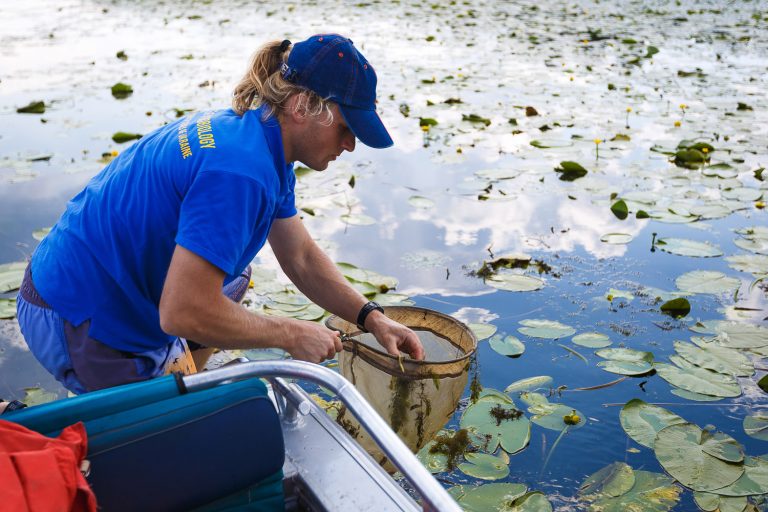
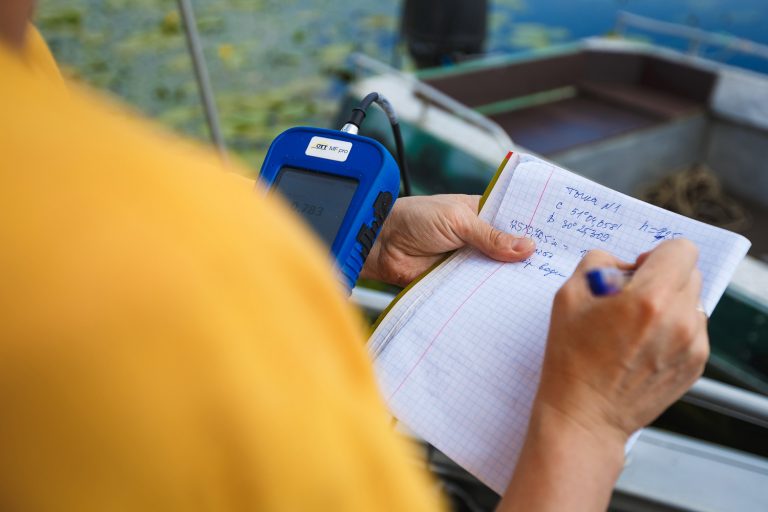
slideshow
Olena says that unlike many other studies where the researchers themselves had to cover the cost of materials and expeditions, this project received a grant of 650,000 hryvnias per year from the National Academy of Sciences of Ukraine. She says this financial support freed up the scientists’ hands significantly, allowing them to collect a lot of different data:
“We have five young scientists, and we need serious funds for business trips and expeditions. And with this grant, we can buy the equipment, reagents, and devices that we lack.”
Priceless data
At each location, scientists first collected meteorological data, such as air temperature, wind speed and direction, to determine whether algae in a particular area were blooming there, or whether they had been brought there by the wind. They also immediately checked the coordinates to mark them on the interactive map, so that they could return and repeat their measurements if necessary.
Next, the project hydrologist Svitlana Batoh checked the basic hydrological and some hydrochemical indicators. With a bathometer — a hollow cylinder with valves that close at the required depth — Svitlana used a bucket to collect a sample of water. Then she immersed the sensors in the water to determine the saturation of dissolved oxygen, and the water’s temperature and pH level (acidity). These measurements are then carried out at different depths.
The scientists store the water collected in a cooler bag, so that they can check other indicators later in the laboratory. For example, Olena and Inna will analyze the level of chlorophyll and thus assess the physiological state of plankton from a particular area. Water samples for the evaluation of hydrochemical indicators such as phosphorus and nitrogen are tested in the laboratory.
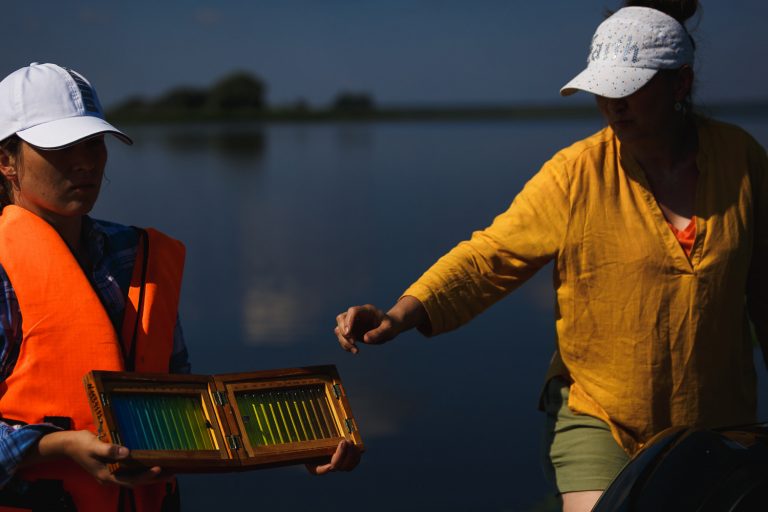
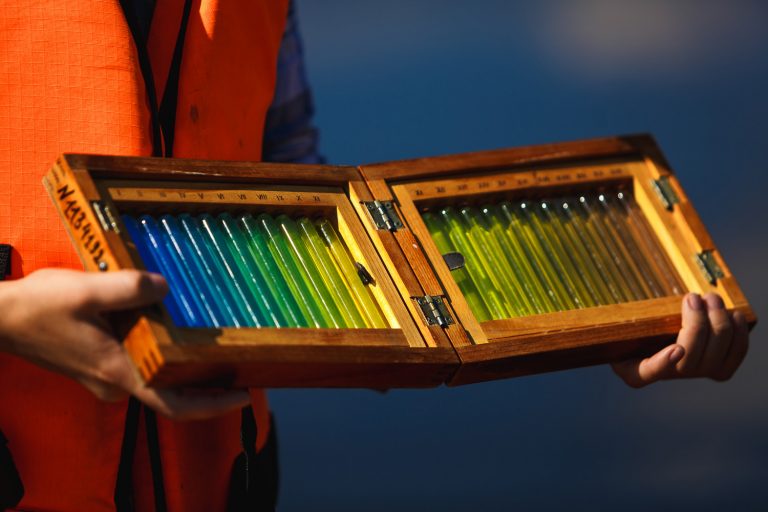
slideshow
In addition to hydrochemical indicators, Svitlana measures hydrophysical aspects. A Secchi disk measures transparency — the depth at which the disk can no longer be seen through the water — while colour is measured through simply comparing colours on a special palette. The speed of the flow is also an important indicator. To check this, scientists use an electromagnetic device with sensors that take multiple repeated measurements and show an average value.
Meanwhile, Ihor Abramyuk catches fish samples with nets. This allows them to observe the species composition of fish living in a particular area, and draw conclusions about fish productivity:
“I catch this year’s fish fry. This way we can see which fish have spawned here. Later I’ll identify the fry under a microscope.”
While his colleagues work at the reservoir, Taras, the project analyst, shoots the location from a drone for the interactive map:
“We’ll produce this map using satellite data which is updated weekly. The satellite images will help us to identify the locations of vegetation. But we won’t be able to see what kind of vegetation it is, since the resolution of the satellite images isn’t that high. Meaning we won’t be able to understand what we’re looking at. For that, we need to calibrate the satellite data with the data from the drone. After that we’ll be able to recognize similar features on the satellite images throughout the whole reservoir.”
Thus, the map will allow us to understand, based on the satellite images, which higher plants are present in a particular area, what area they occupy, and to determine their biomass. The maps of the reservoir are already ready. They are based on satellite images and a relief map of the river bottom, with several layers superimposed. One layer marks points from the expedition and contains links to the data collected there. Another layer shows zones where higher aquatic plants grow, and allows the scientists to calculate the area they occupy. The intensity of the colour of the third layer reflects how large the biomass of algae is in a particular area. By comparing information from the different layers and analyzing data in the laboratory, the team will be able to identify certain patterns.

But their work will not end there: the scientists will modify their hypothesis based on the new information, and possibly choose new locations for data collection. Or, they may find an unexpected pattern, add more indicators to their research plan, and repeat their measurements the following year. Only then the researchers will be able to confirm or refute their hypothesis and know whether certain plants can prevent the blooming of the Dnipro.
The project Olena leads is two years of painstaking work that will not in itself solve the problem of blooms — but will help to obtain invaluable data. It will deepen understanding of the processes taking place in the Dnipro; of its hydrological regime and the relationships between living organisms. This knowledge will enable scientists to suggest an effective and, most importantly, sustainable way to reduce the intensity of blooms, and will aid in better decisions to maintain the health of the country’s main river.

